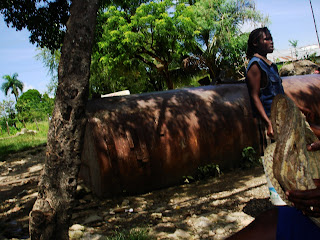The John Mayer song ‘3x5’ from his first album, Room for Squares, has always rung true for me. It begins, thus--
I'm writing you to
catch you up on places I've been.
And you have this letter,
probably got excited,
but there's nothing else inside it.
Didn't have a camera by my side this time,
hoping I would see the world through both my eyes.
Maybe I will tell you all about it when I'm
in the mood to lose my way with words--
The whole song is beautiful, and like I said, true. I really admire and wish I were skilled at photography, but I’ve never been a picture-taker because I like to live what I’m experiencing. I get too wrapped up in what I’m doing and thinking to remember to capture it on film. That said, it’s a little strange that my personal project here is to create a photographic presentation of the Dominican Republic and the work of Makarios for Dominican Joe. In reconciling my photographic philosophy and my purpose here, I’ve tried to live and let my camera tag along on my experiences, remembering to actively include it from time to time.
Another thing I’ve had difficulty with, though, is trying to articulate and communicate verbally all that is happening. Like all things truly meaningful, it’s nearly indescribable, both because I could not relay the sheer volume of experiences, people, scenery, thoughts, revelations, and prayers, and because I think that perhaps some of these things weren’t meant to be understood by others. Maybe some of them are just for me, ya know?
So, those things said, below are pictures from this past week. A short caption is included under each one, and though the picture is supposed to communicate 1,000 more words, I know that it’s insufficient for what is in my heart and head. My prayer, however, is that it is precisely sufficient for what it has been purposed to accomplish.

Coffee beans.
These organic coffee beans grow high in the Central Mountain Range of the Dominian Republic on the Doulos Farm, owned by an American man and his wife, that employs Dominicans and Haitian immigrants. The farm pays employees fair wages that allow them to afford adequate housing, have access to potable water, and other goods and services. The coffee from the farm is sold to Makarios, who acts as the broker for the trade, exporting it to the United States to be bought by Dominican Joe in Austin. Proceeds from Doulos supports the Doulos School in Jarabacoa, which educates kids from kindergarten to 12th grade, promoting academics and student leadership. The profit that Makarios makes on the coffee, in selling it to Dominican Joe, helps to support Makarios' educational initiatives.
These organic coffee beans grow high in the Central Mountain Range of the Dominian Republic on the Doulos Farm, owned by an American man and his wife, that employs Dominicans and Haitian immigrants. The farm pays employees fair wages that allow them to afford adequate housing, have access to potable water, and other goods and services. The coffee from the farm is sold to Makarios, who acts as the broker for the trade, exporting it to the United States to be bought by Dominican Joe in Austin. Proceeds from Doulos supports the Doulos School in Jarabacoa, which educates kids from kindergarten to 12th grade, promoting academics and student leadership. The profit that Makarios makes on the coffee, in selling it to Dominican Joe, helps to support Makarios' educational initiatives.


To get to the farm, we drove 40 minutes up a mountain, missed a few pot-holes/areas where the road ceased to exist, then parked on a dirt road in the middle of what appeared to be goard vineyard/village, walked 20 more minutes up the mountain, and passed over rivers by wooden bridges like this one.

Cows and horses sometimes appeared on our walk up to the Doulos Farm.

In the United States, we buy these at Wal-Mart or, if we're really in touch with nature, at the local organic nursery, and then plant them in our wooden boxes made just for flowers. In the Dominican Republic, they grow in the wild.

Paint on the side of someone's house on the mountain.

I think I find large plant products novel (like the California Redwoods and their byproducts, namely, pine-cones). I liked this leaf.

Marissa and I hating the worst internship ever, as we like to call it.

Little Rachel enjoying herself at Literacy Camp

Little Rachel enjoying herself at Literacy Camp

Front door of a house in Tamarindo.

Tamarindo.

This sweet lady lives across the street from the Makarios school and owns a colmado, which is like a convenience store in a shack-esque establishment. We talked for a few minutes, and she told me that her older son used to go to Makarios' after school program for the older children.

This sweet lady lives across the street from the Makarios school and owns a colmado, which is like a convenience store in a shack-esque establishment. We talked for a few minutes, and she told me that her older son used to go to Makarios' after school program for the older children.

This is me on Cecilia's porch (courtesy of Jody--thanks Jody!). Cecilia is an older lady who lives in Tamarindo and owns a colmado. She and I have become fast friends and I look for times to sneak away from Literacy Camp to hang out with Cecilia on her porch or in her house. She tells me about raising 7 children, raising the little girl down the street now that she is vieja (old), and sometimes cooks me food. She's great, and makes me wonder why we don't sit on our porches more often, just to invite people in.
Here are some of our children eating breakfast at Literacy Camp. They love their guinaos (bananas)!

Hello! I'm sweet and love to tirar fotos and live in Tamarindo just down the dirt driveway from the Makarios School!
-
Franchesca in Chichigua last Tuesday. I went to visit for the afternoon after Literacy Camp.

Memo's head is a little smaller than mine. (Notice the sugar cane field in the background and the fence to the right--The canes in the back are where many Chichiguans used to work, back when sugar cane was more profitable and they could find jobs. The fence to the right marks the property line of the farm next to Chichigua. While I was getting my hair braided on Tuesday, the farmer came over and had a heated confrontation with some Chichiguan men about who had left the gate 0pen, which allowed his cows to escape. When I left, we still weren't sure who the culprit was, or where the cows had ended up. The entire confrontation was a little scary, as they were yelling in Creole I couldn't understand, so to take my mind off of the debate, admired the farmer's moto that has estickers (stickers) plastered on the sides. My favorites were the encouraging, glittery messages like, "¡Fantástico!", and the Canadian flag.)

Joselina is 12 years old and lives in Chichigua with her sister and mother. She loves to smile and loves to go around the batey and see what's happening. She, Franchesca, and Memo all wanted to try out my helmet. They, like my Makarios "friends", thought it was pretty funny.

Franchesca in Chichigua last Tuesday. I went to visit for the afternoon after Literacy Camp.

Memo's head is a little smaller than mine. (Notice the sugar cane field in the background and the fence to the right--The canes in the back are where many Chichiguans used to work, back when sugar cane was more profitable and they could find jobs. The fence to the right marks the property line of the farm next to Chichigua. While I was getting my hair braided on Tuesday, the farmer came over and had a heated confrontation with some Chichiguan men about who had left the gate 0pen, which allowed his cows to escape. When I left, we still weren't sure who the culprit was, or where the cows had ended up. The entire confrontation was a little scary, as they were yelling in Creole I couldn't understand, so to take my mind off of the debate, admired the farmer's moto that has estickers (stickers) plastered on the sides. My favorites were the encouraging, glittery messages like, "¡Fantástico!", and the Canadian flag.)

Joselina is 12 years old and lives in Chichigua with her sister and mother. She loves to smile and loves to go around the batey and see what's happening. She, Franchesca, and Memo all wanted to try out my helmet. They, like my Makarios "friends", thought it was pretty funny.

This is my friend in Chichigua who braided my hair! She asked if she could, and well, I'm bad at saying no. I explained to her and her friends that the last time somebody me peinó el cabello (braided my hair), I was 12 and in Mexico, and it didn't look cute. I don't know if a ella no le importaba (she didn't care) or didn't understand that gringos generally don't braid their hair for a reason (it actually doesn't flatter us), but either way, I ended up looking like Kevin Federline and having a great conversation.

Tuesday night we killed a large spider with some bug spray and this Banana Republic shoe (sorry, Marissa!). The spider left his goodbye to the world by leaving the bug spray from his exoskeleton on the bottom of the shoe. ...It's like those handprints you make for your mom in 3rd grade art class...but not.


...thanks be to God, which always causes us to triumph in Christ, and makes manifest the aroma of his knowledge by us in every place.
I Corinthians 2:14



































